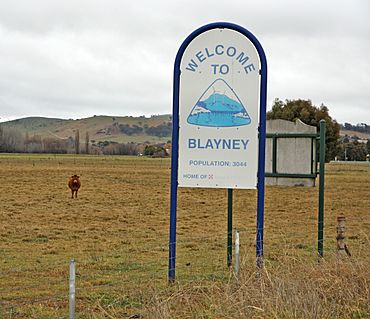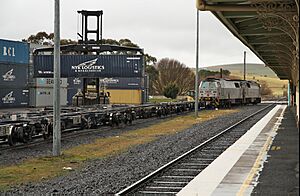Blayney, New South Wales facts for kids
Quick facts for kids BlayneyNew South Wales |
|||||||||
|---|---|---|---|---|---|---|---|---|---|

Town Entry Sign on Mid Western Highway
|
|||||||||
| Population | 2,997 (2021 census) | ||||||||
| Postcode(s) | 2799 | ||||||||
| Elevation | 863.0 m (2,831 ft) | ||||||||
| Location | |||||||||
| LGA(s) | Blayney Shire | ||||||||
| State electorate(s) | Bathurst | ||||||||
| Federal Division(s) | Calare | ||||||||
|
|||||||||
Blayney is a friendly farming town in the Central West region of New South Wales, Australia. About 2,997 people lived here in 2021. It's located about 240 kilometers (150 miles) west of Sydney and 35 kilometers (22 miles) west of Bathurst. Blayney is also the main office for the Blayney Shire Council.
Contents
History of Blayney
Before European settlers arrived, the land around Blayney was home to the Aboriginal Wiradjuri and Gundungara peoples.
The first European explorer to visit this area was George Evans in 1815. People started settling here unofficially around 1821. The first official land grant, which is like giving someone permission to own land, was given to Thomas Icely in 1829.
In 1836, the area was known as King's Plains. There was an inn and a mill. In 1842, the Governor of New South Wales, Governor Gipps, suggested creating a village called 'Blayney'. The first spot wasn't quite right. So, the town was officially set up in its current location in 1843.
A train line used to carry lime from Blayney to nearby kilns. You can still see parts of these old lime kilns today near the Blayney Cemetery.
Historic Places in Blayney
Blayney has several places that are important to its history. These are called heritage-listed sites. They include:
- Adelaide Street: Blayney Uniting Church
- Main Western railway: Blayney railway station
What Blayney Offers
Blayney has many useful places and services for its residents and visitors.
Shops and Services
You can find three hotels in Blayney: The Exchange, the Royal, and Tattersalls. There are also six churches, including Catholic, Uniting, Anglican, Presbyterian, and Pentecostal. For shopping, there are three service stations and a supermarket. You'll also find various other shops.
Community and Health
Blayney has a multi-purpose Community Centre. It has a large hall and a kitchen. The local council also runs an aquatic center with an indoor swimming pool and other exercise facilities. There is also a public library. The town has both government-run primary and high schools. Students from nearby farms come to school by bus. There is also a Catholic primary school. The local hospital provides emergency and medical care. For more serious health issues, patients are transferred to Orange Base Hospital. There is a public toilet available 24 hours a day on Adelaide Street.
Blayney's Industries

The arrival of the railway in 1874 helped Blayney grow a lot. It became the main service center for local farms. Blayney became a municipality (its own local government area) in 1882. By 1900, a butter factory and freezing works provided many jobs.
Later, a place for processing meat opened in 1957. This industry grew to include tanneries, which process animal hides, and a pet food plant. The meat processing plant closed in 1999.
In the late 1970s or early 1980s, a factory was built to can meat, including Spam. This factory later became a place for preparing meat for export. Then, it became a pet food factory.
In 1989, Nestlé built a new pet food plant called Nestlé Purina PetCare. This factory sends pet food to countries in Asia and the Pacific.
The Cadia-Ridgeway Mine is also a very important employer in the area.
In 1994, Blayney became home to Australia's largest inland container terminal. This is where large shipping containers are moved between trains and trucks. It's located next to the railway station.
The Blayney Wind Farm, which started in 2000, is one of the biggest of its kind in Australia. It has 15 large wind turbines on hills. It can produce enough energy to power 3,500 Australian homes.
Blayney's Climate
Blayney is in a valley, so its temperature changes a lot between day and night. Summers are warm and dry, sometimes with big thunderstorms. Winters are cool and often cloudy. It even snows a few times each year! The coldest temperature ever recorded in Blayney was -10.6 degrees Celsius.
Getting Around Blayney
The town's railway station has a daily train service, the NSW TrainLink XPT, that goes between Sydney and Dubbo. There's also a weekly train called the Outback Xplorer that goes to Broken Hill. You can also find several bus services that connect Blayney with Bathurst and Orange.
Famous People from Blayney
- Nathan Burns: A professional football (soccer) player who played for Wellington Phoenix and the Australian national team.
- Frank Cooper: He was the Premier of Queensland, a state leader, from 1942 to 1946.
- Liam Henry: A rugby league player for the Penrith Panthers.
- Peter McCann: An Australian rules footballer.
- Peter Toohey: An Australian Test cricketer from the late 1970s.
Images for kids

















